Top 10 Things to See in Regensburg: What’s Really Worth Your Time?

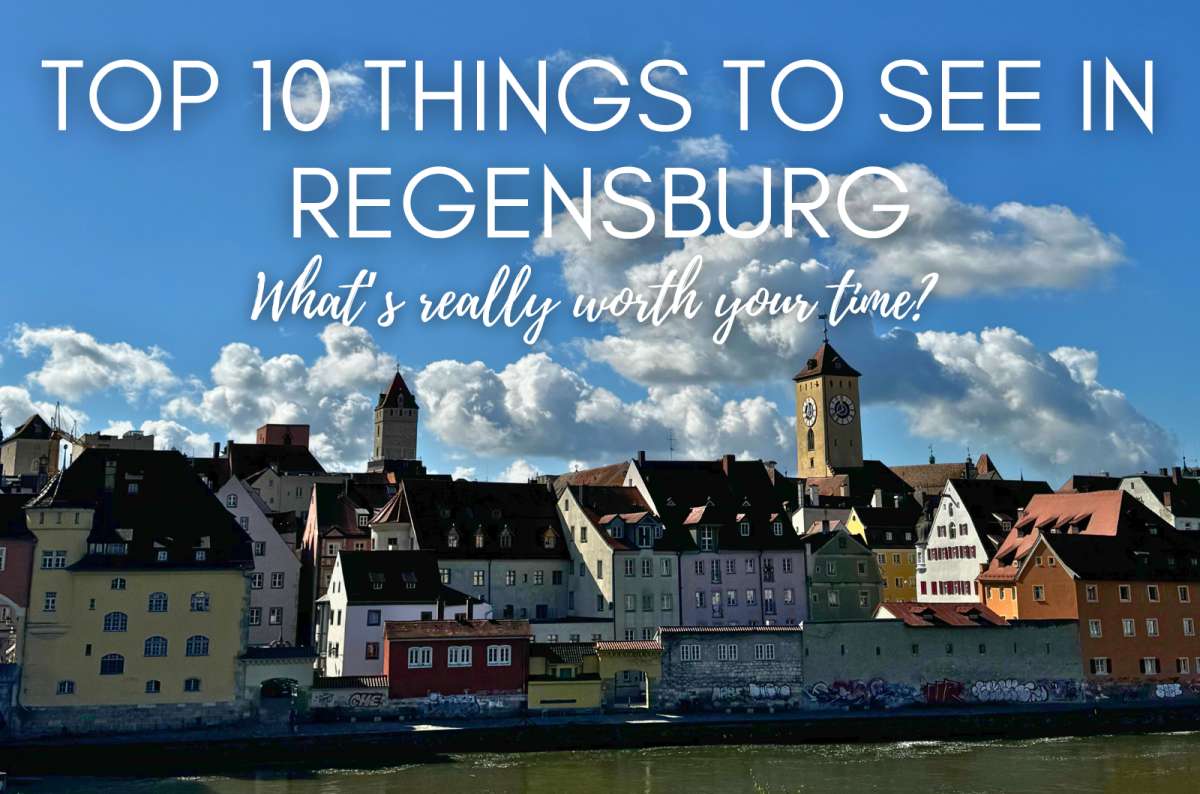
Quick Look: The Best Things to Do in Regensburg
Map of Regensburg sightseeing highlights
So why do I recommend just half a day in Regensburg?
1. Regensburg’s Stone Bridge and the Best View of the Cathedral
2. Regensburg’s St. Peter's Cathedral: An Iconic Building with Incredible Organ Music
3. Walhalla Memorial—A Must-See Near Regensburg
4. Porta Praetoria—A Roman Gate Hiding in Plain Sight
5. Goliathhaus and Regensburg’s Patrician Towers—How Rich Merchants Tried to Outbuild Each Other
6. St. Jakob Church aka Scots Monastery–See Regensburg’s Romanesque Hidden Gem
7. Neupfarrplatz and Haidplatz—Explore Regensburg’s Old Town Squares
8. Old Town Hall, Where a 143-Year-Long Meeting Was Held
9. The Old Chapel—Bavaria’s Oldest Catholic Church
10. House of Bavarian History—A Must-See Museum in Regensburg for Real Context
Sample Itinerary: One Day in Regensburg
Final Tips for Visiting Regensburg
Is Regensburg a day trip from Munich?
Can I visit Regensburg from Nuremberg?
Wondering if Regensburg is worth visiting? I was too; turns out it’s one of the best-preserved medieval cities in Germany and makes for an excellent day trip from Munich or Nuremberg.
Regensburg’s UNESCO-listed Old Town is packed with history—much to the joy of a history nerd like me: Roman ruins, Gothic cathedrals, and even the medieval towers built by merchant families trying to outdo each other.
Many of the buildings are originals from the 12th and 13th centuries, because unlike nearby Nuremberg, Regensburg pulled through WWII undestroyed. Additionally, the city was a major power center in the Holy Roman Empire, so walking around honestly felt surreal.
Read more from my Germany travel blog.
Quick Look: The Best Things to Do in Regensburg
-
Walk the Stone Bridge for the best views in town
-
Visit the massive Regensburg Cathedral
-
Detour to the Walhalla memorial just outside the city
-
Find the ancient Porta Praetoria Roman gate
-
Spot the Goliathhaus and the show-offy patrician towers
-
Step inside St. Jakob Church aka Scots Monastery
-
Wander the old town squares: Neupfarrplatz and Haidplatz
-
Explore the medieval Altes Rathaus (Old Town Hall)
-
Visit the flamboyant Old Chapel
-
Check out the House of Bavarian History
Sometimes, all you need to do is take the first step... I've filtered out the best hotels in Regensburg for you.
Save it for yourself to come back to later, or share with your friends on social media!
Map of Regensburg sightseeing highlights

Map of Regensburg’s top things to see
So why do I recommend just half a day in Regensburg?
You could spend a full day here, but honestly, half a day is enough to cover all the essential must-sees in Regensburg. It’s not exactly huge, and a lot of what you can see there is literally just there—you walk around and there it is.
That’s why this isn’t a bloated list of 100 things to do in Regensburg. It’s just not that kind of city. I’m not going to waste your time listing every old building just to pretend Regensburg has more to do than it actually does. I just chose the places that I really thought were worth my (and now your) time.
That said, if you’re taking it slow, spending time at the House of Bavarian History and then heading outside the city to the Walhalla memorial, or even including the Thun and Taxis Palace too, you’ll turn this into a full day trip, no problem.
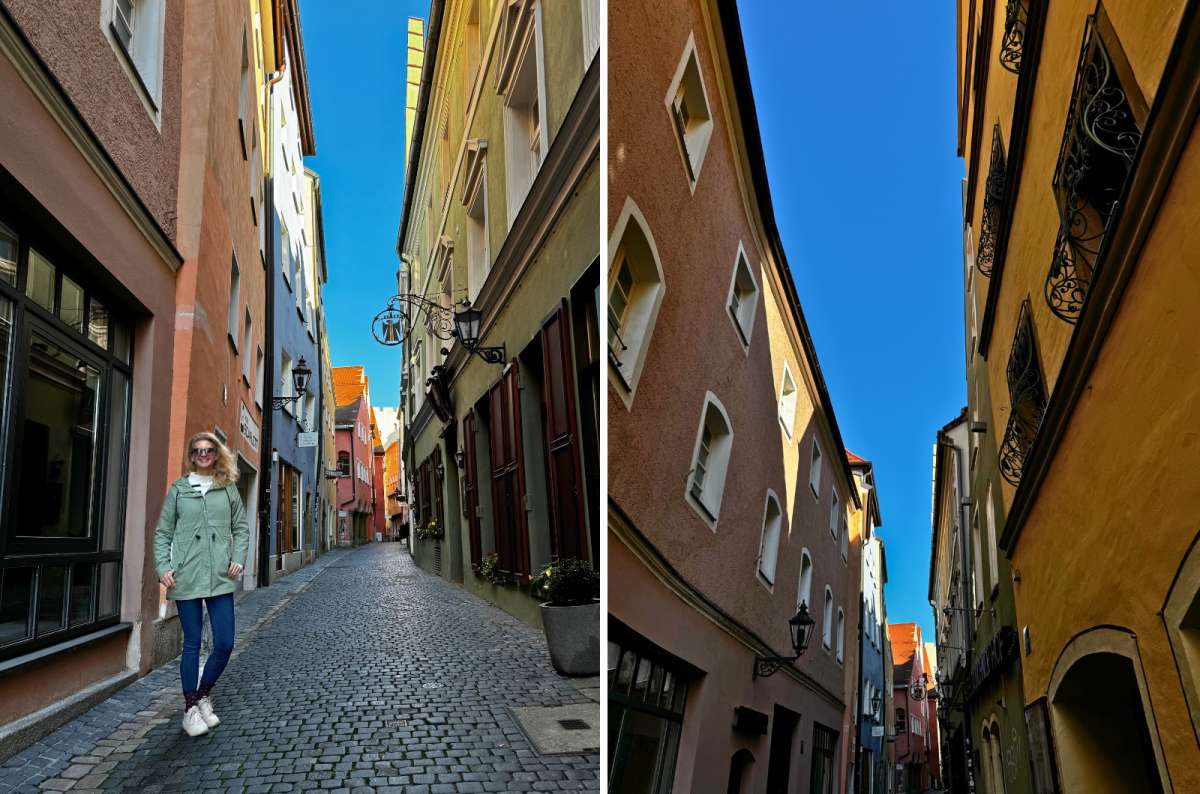
Walking through the Old Town on a day trip to Regensburg

What is Regensburg known for?
The medieval atmosphere is the main attraction in Regensburg. The cobbled streets, old building facades, towers built by rich families… and the Danube before it gets lazy and wide. (Have I mentioned that the Danube is my favorite river?)
Regensburg is just full of surprisingly intact history—from Roman gates to Gothic cathedrals and even the slightly out-of-place Walhalla, which isn’t technically in Regensburg but sits just outside the city (but looks like you landed in Greece).
Also, Nuremberg is only about an hour’s drive away—and if you haven’t already, check out my Nuremberg itinerary to see why it deserves a full day of its own.
Let’s get into the details of the unmissable things to see in Regensburg, starting with a bridge that’s older than most countries:
1. Regensburg’s Stone Bridge and the Best View of the Cathedral

The Stone Bridge is where you’ll get the best views of Regensburg’s Old Town
- Why it’s worth it: It’s an old and scenic bridge that gives you the best photo angle of the city.
The Stone Bridge (Steinerne Brücke) is one of the oldest surviving bridges in Europe, built in the 12th century. To be honest, it looks suspiciously modern now—did someone go overboard on renovations??
Still, it’s cool to think that actual crusaders marched across this very bridge a thousand years ago. And now it’s you and me taking too many photos from it. This is where you will take the best shots of the massive Regensburg Cathedral and the Old Town.
If you cross the bridge, you’ll find yourself on an island on the Danube that serves as a park. If you’re hoping to get a photo with the bridge in it, you’ll need to head over to the island to do so.
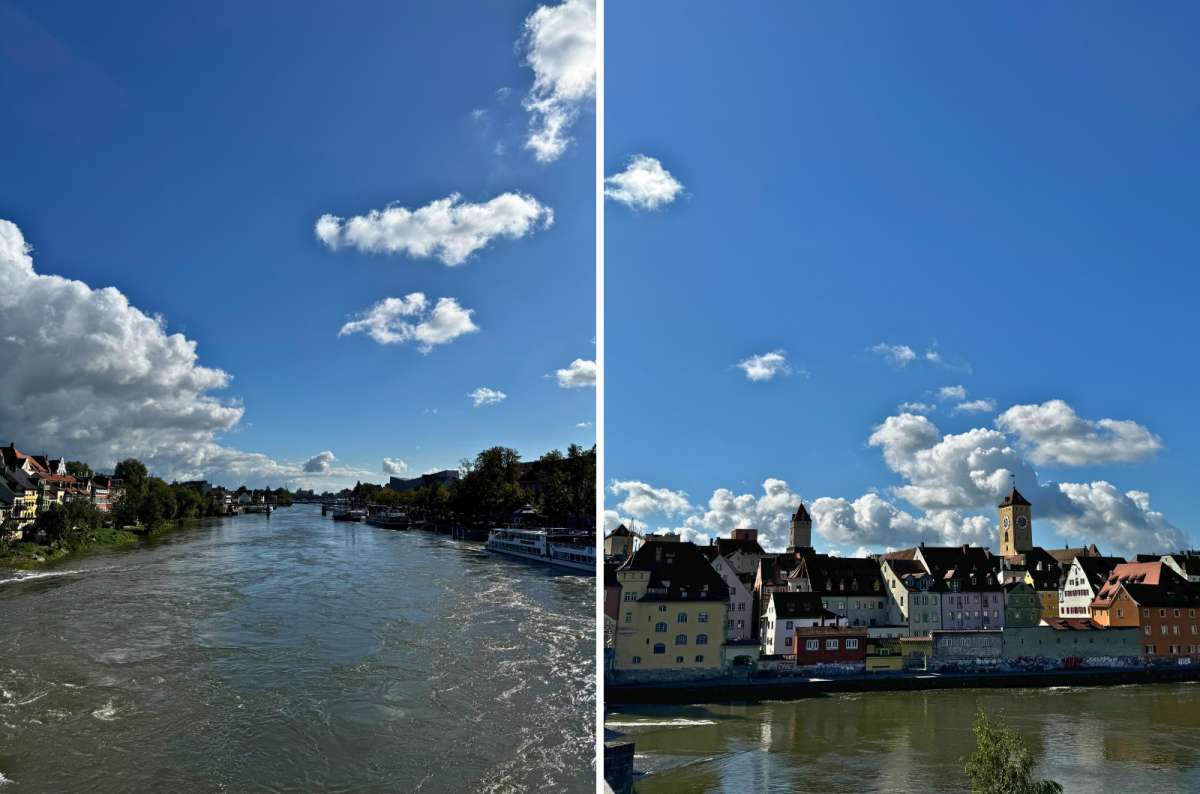
Views from the Stone Bridge in Regensburg—perfect for capturing the Danube
2. Regensburg’s St. Peter's Cathedral: An Iconic Building with Incredible Organ Music
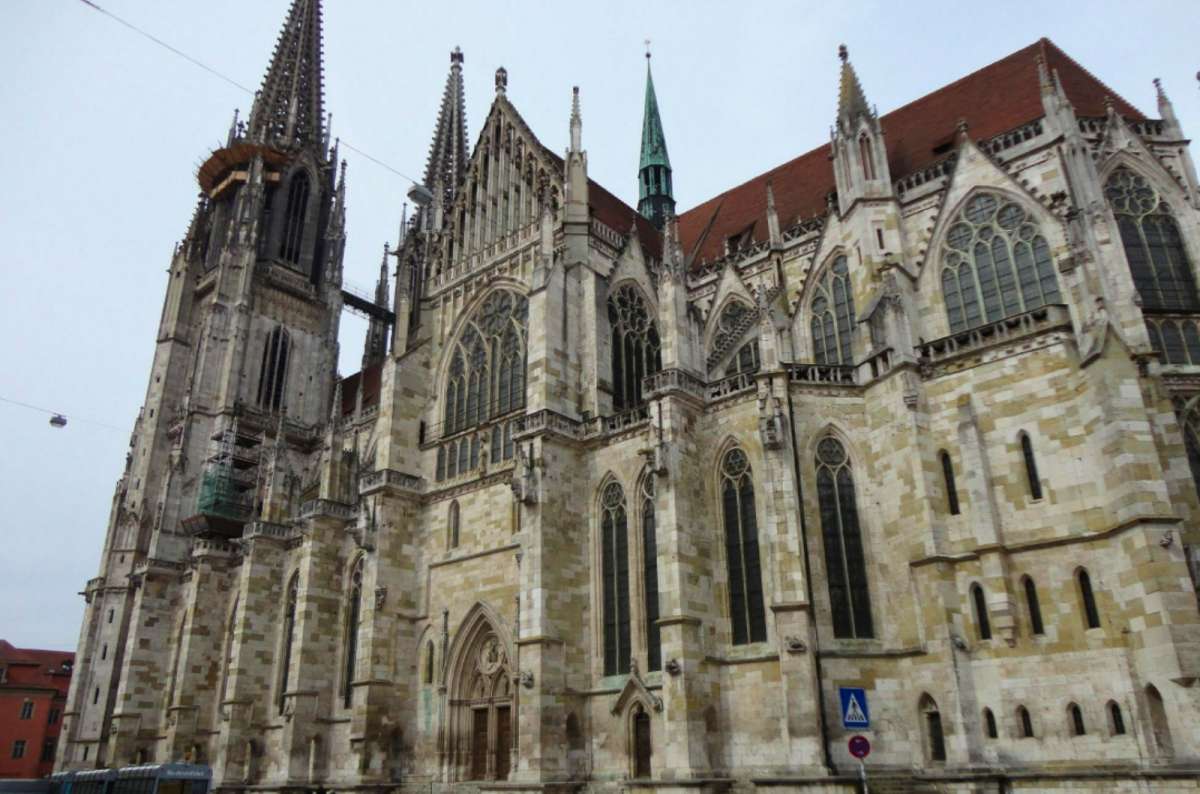
St. Peter’s Cathedral @ Regensburg
-
Why it’s worth it: It’s the tallest thing in town, and the organ music will blow you away if you manage to hear it play.
-
Opening hours: Monday to Saturday 6:30 am–7 pm, Sundays from 1 pm (or mass at noon)
-
Free entry
The Regensburg St. Peter’s Cathedral (Dom St. Peter) is impossible to miss, and one of the essential places to see in Regensburg. It’s massive.
It's the most iconic religious building in Regensburg and one of the most famous Gothic cathedrals in southern Germany. That said, don’t expect too much from the inside unless you can visit when the organ is playing. Overall, I found the interior surprisingly plain for its size.
But what blew me away was the acoustics! I happened to walk in during Sunday mass, and the organ and the choir sounded incredibly powerful… You know how a plane taking off rattles your insides? It was kind of like that. And I’m not even religious.
Pro tip: In the summer, there’s supposed to be a “midday contemplation” with organ music for 15 minutes every weekday. A little tip if you’re not there for Sunday mass and still want a shot at said insides being rattled.
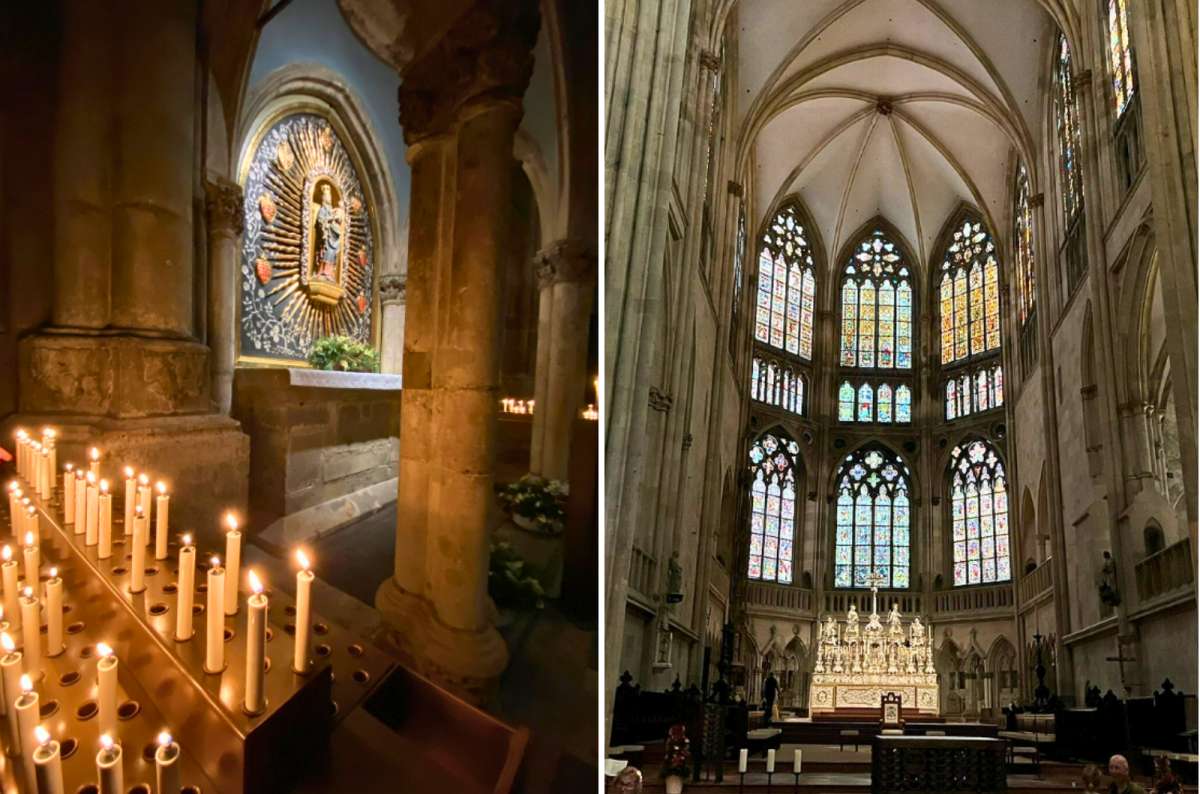
Regensburg Cathedral nails the dramatic contrast—moody crypt vibes below, full-on stained glass glory above
3. Walhalla Memorial—A Must-See Near Regensburg
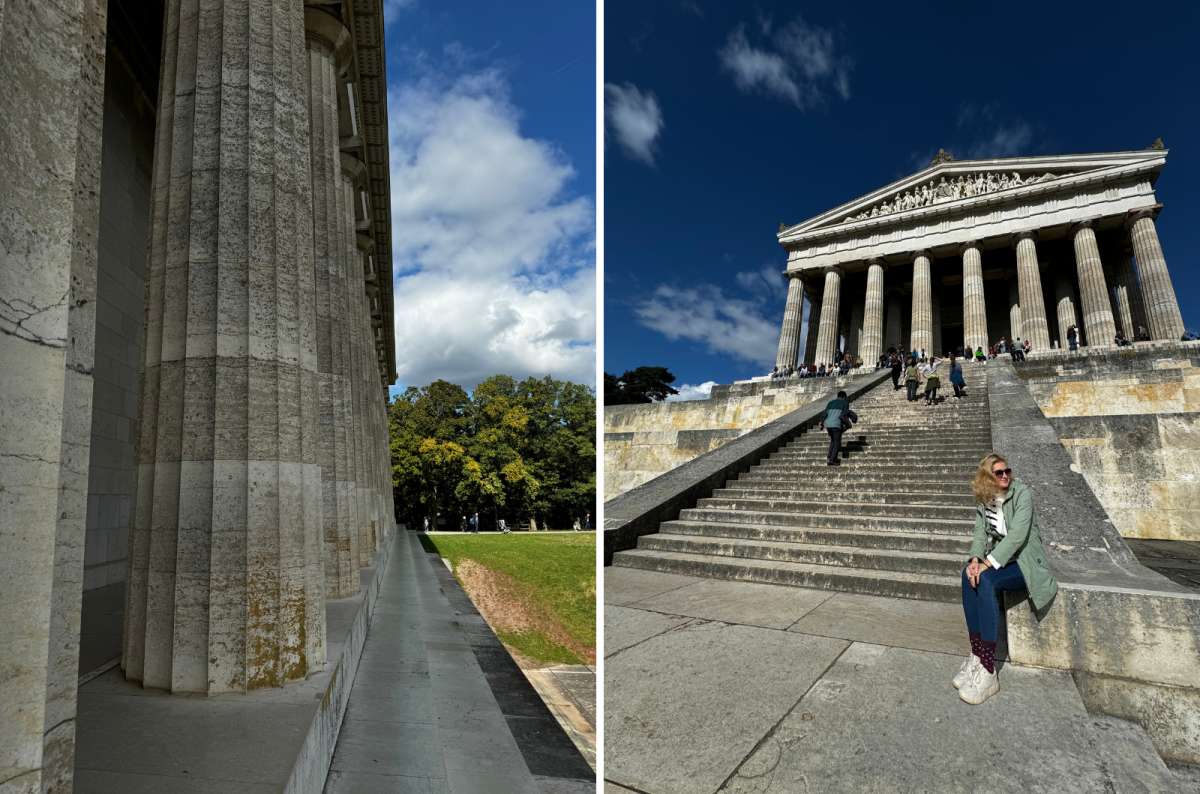
The Walhalla, a Greek-style temple honoring famous Germans, sits just 15 minutes from Regensburg
-
Why it’s worth it: It looks like a Greek temple had a baby with a Nazi monument.
-
Price: EUR 4.50 + EUR 2.50 for parking
-
Opening hours: Daily 9 am–6 pm (closes at 4 pm between November and March)
-
Location: About a 15-minute drive from Regensburg, near Donaustauf, your GPS will take you straight to the parking lot
Walhalla isn’t right in Regensburg, but it’s close enough to count as one of its attractions. It’s about 15 minutes outside the city, sitting pretty way above the Danube. You can’t miss it, it sticks out like a sore thumb from far away. I wouldn’t travel across Germany to see it, but it is a popular attraction near Regensburg for a reason.
So, what is it? It was built in the 1800s as a hall of fame for “great Germans”—politicians, scientists, composers, and military figures.
The building is in the style of a Greek temple, with rows of massive columns packed closer together than they have any reason to be, and white marble everything. It’s as random as it sounds and it’s obvious someone tried hard to make an impression.
I was expecting to learn that it’s a Nazi power display, sort of like Hitler’s Eagle’s Nest. You know, less about functionality, more for showing off obnoxiously. But it isn’t.
The interior is a large hall with over 100 stone heads staring at you and plenty of plaques explaining the greatness of each of them. I honestly expected it to be bigger, because it looks bigger from the outside.
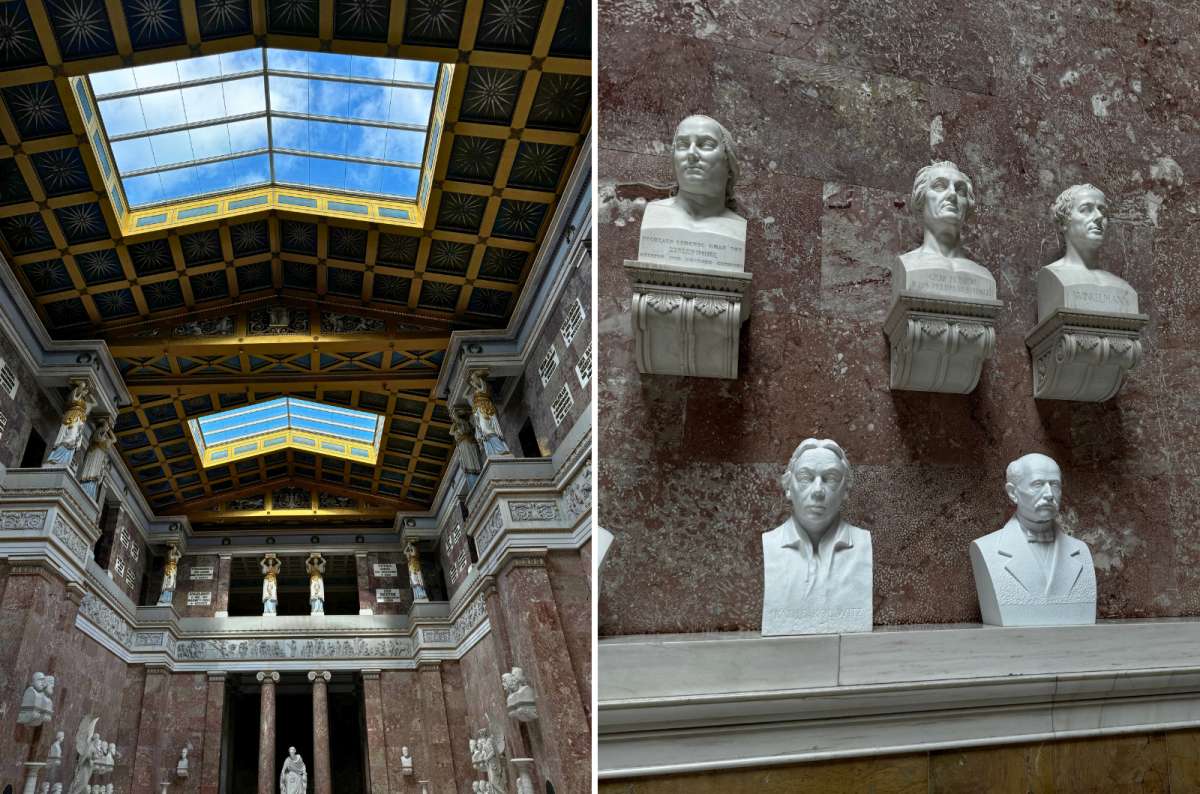
A hall packed with over 100 marble busts of “great Germans”—it feels smaller than it looks from the outside
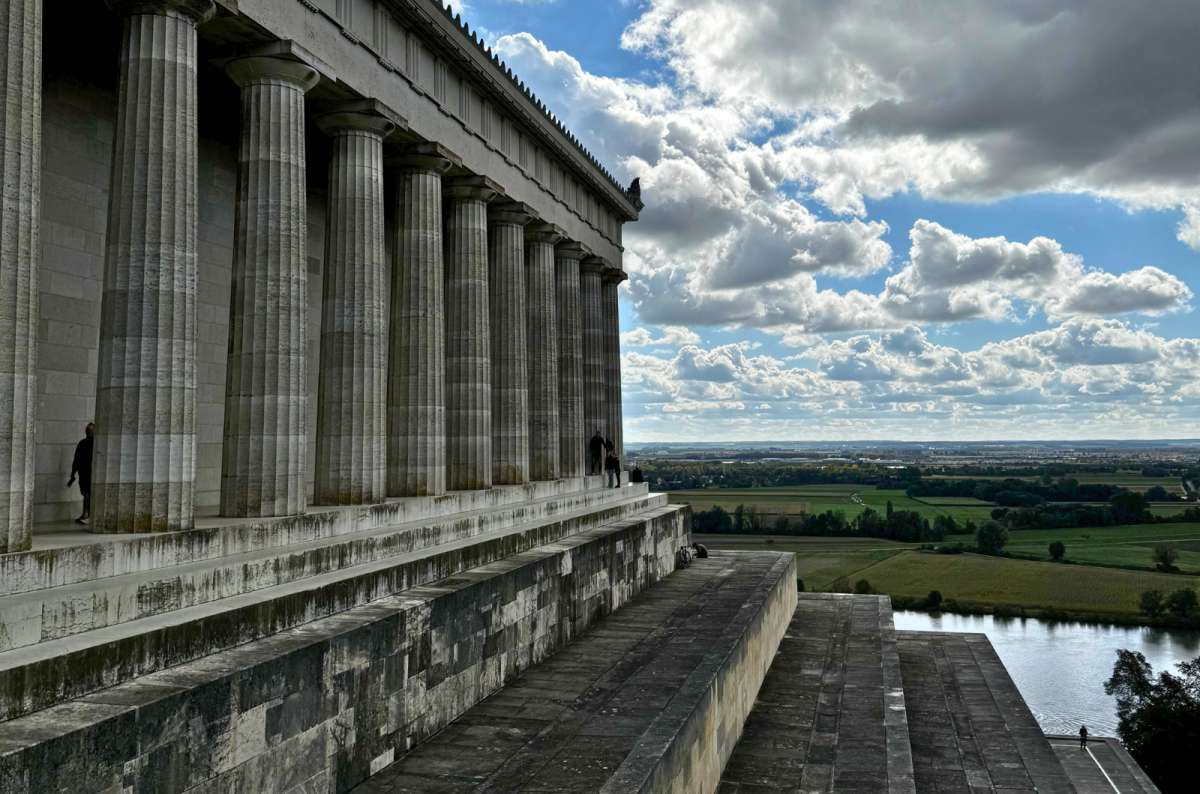
Bonus: Insane views over the Danube!
4. Porta Praetoria—A Roman Gate Hiding in Plain Sight
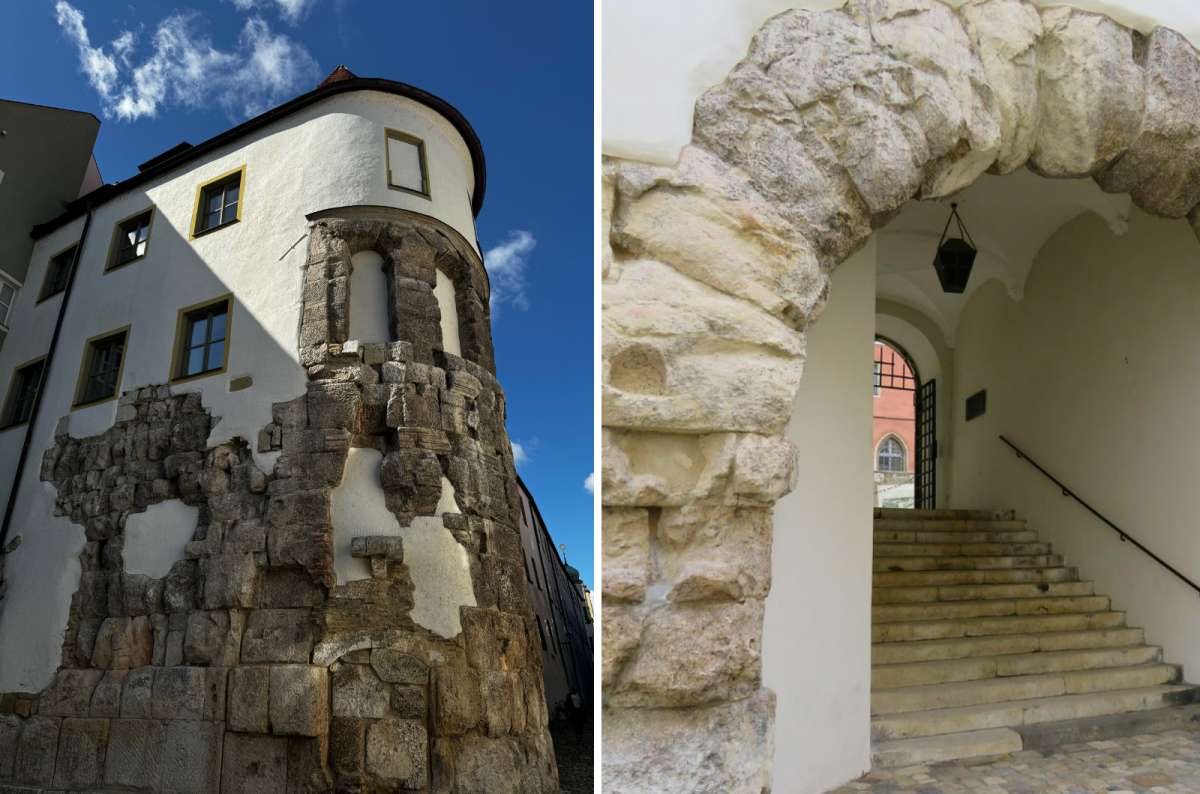
This Roman gate from 179 AD is casually built into a house now
- Why it’s worth it: It’s one of the oldest things in Regensburg and the only surviving Roman gate north of the Alps.
Porta Praetoria, the former northern gate of the Roman military camp Castra Regina, is easy to walk past without even noticing it. But you’ll want to pay attention, because this thing has been standing there since the 2nd century.
To set expectations straight: you won’t see a fully intact Roman gate—just part of the eastern tower and one small arch have survived. The rest was swallowed up by later buildings and only rediscovered when a brewery that had absorbed the old walls was torn down much later. Today, the original Roman stone is exposed and fully visible. But get this:
This ultra-significant Roman relic now serves as the entrance to a beer garden. You can tell you’re in Bavaria.
5. Goliathhaus and Regensburg’s Patrician Towers—How Rich Merchants Tried to Outbuild Each Other
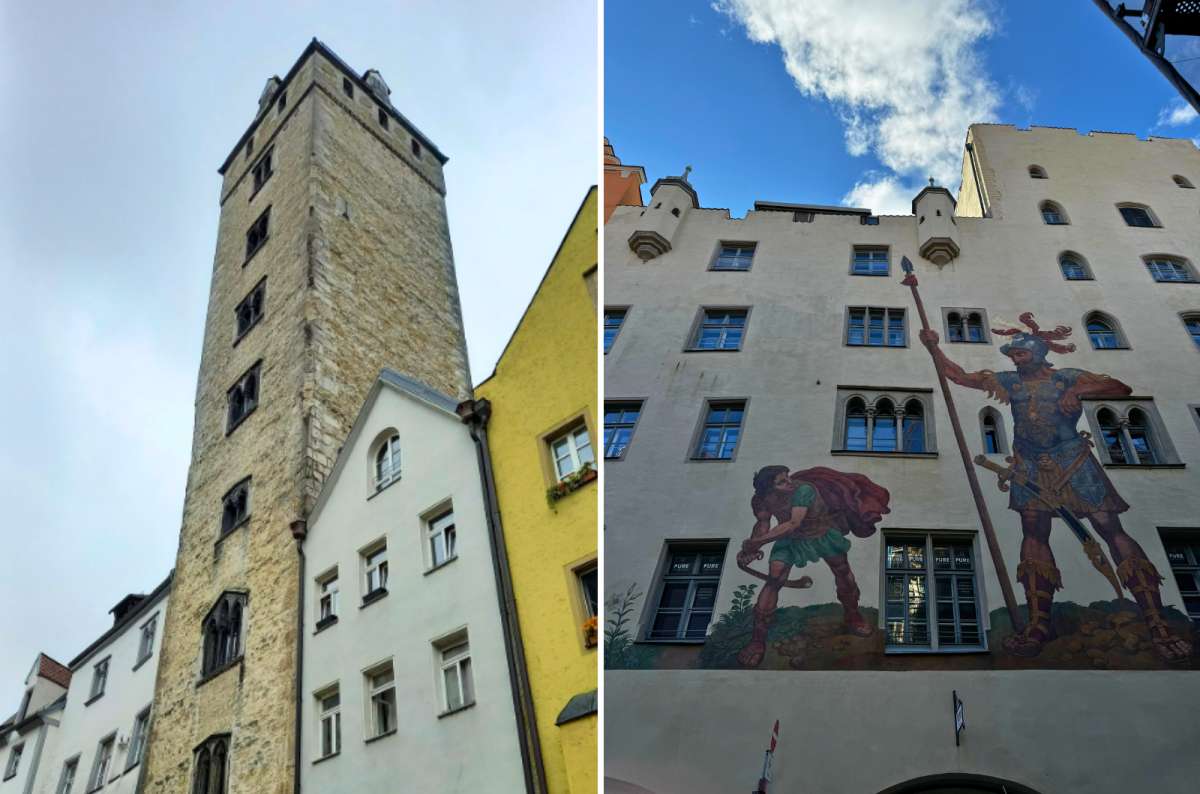
Left: the tallest tower in town—Golden Tower (now student housing); right: the epic Goliathhaus mural (now with Goliath leaning against the window)
- Why it’s worth it: These towers are scattered all over the Old Town—they used to be status symbols. Once you spot one, you’ll start seeing them everywhere.
One of the best things to do in Regensburg is finding all the towers—I was walking through the city and suddenly realized I’m surrounded by them. You don’t need to go looking for any specific one, it’s fun just seeing what’s been done to them nowadays.
What’s up with the towers? Patrician families—mostly merchants—built them to try to one-up each other. The family with the highest tower was the richest most affluential, so they just kept building bigger and better ones, trying to be better than the next guy.
Back in the 12th–14th centuries, there used to be about 60 patrician towers attached to family residences, but today, about 20 remain standing, some slightly awkwardly fused into more modern buildings.
The tallest towers in Regensburg
Look for the Golden Tower (Goldener Turm)—it’s the tallest surviving example. It’s 9 stories tall, located on Wahlenstrasse. It’s now student housing with over 40 shared apartments. Pro tip: You can peak inside the tiny inner courtyard.
Baumburg Tower is nearby and only 7 stories tall, but it’s pink! Notice the balcony where they used to display goods for sale.

The tower of the Stone Bridge + the pink Baumburg Tower with its display balcony
Goliathhaus, the famous patrician house
And then there’s Goliathhaus—not a tower, but easily the most recognizable patrician house in Regensburg. The reason you and every other tourist will visit it is the massive mural of David and Goliath, originally painted in the 1500s (and restored many times since then).
Goliath didn’t used to rest his elbow on one of the windows, but I understand he’s getting a bit tired of standing around like a cocky tank, waiting for David to bullseye him right between the eyes.

6. St. Jakob Church aka Scots Monastery–See Regensburg’s Romanesque Hidden Gem

The museum’s modern glass front merges Bavarian history with the present
-
Why it’s worth it: It’s one of the oldest churches in Regensburg, with original Romanesque details and a surprisingly cool modern entrance.
-
Free entry
-
Opening hours: Daily 8 am–6 pm
Another worthwhile thing to do in Regensburg is this monastery turned church. I really liked St. Jakob Church, or the Schottenkirche—it isn’t flashy or crowded. That, and the fact that you enter through a modern glass structure.
It was originally built by Irish monks as part of a monastery. Later, it was taken over by Scottish monks (hence the “Scots Monastery” name), and it stayed active all the way into the 1800s. So yeah, it’s now a church, but it used to be part of a much larger religious complex. That’s probably why it feels bigger than it looks.
What to expect inside (and out)
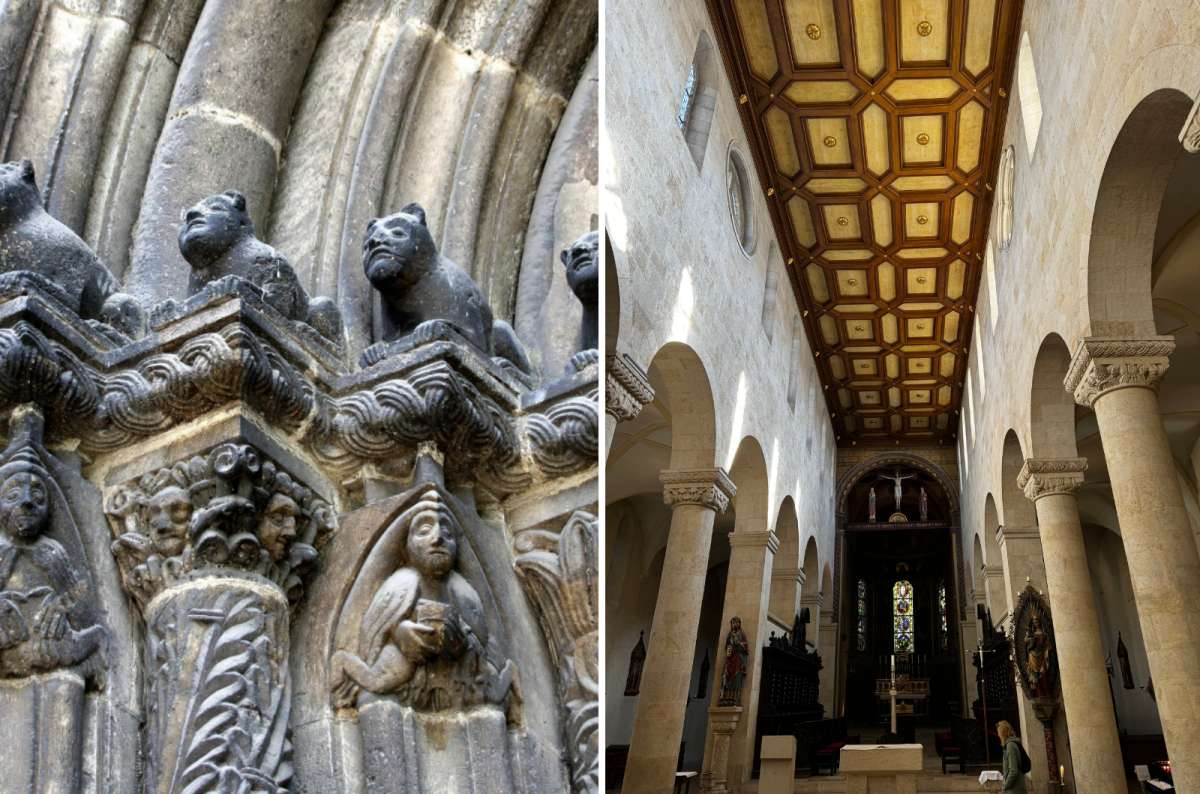
Tip: Don’t miss the tucked-away chapel gallery—it’s like a hidden second church
The glass “box” on the outside protects the original 12th-century northern entrance and all the Romanesque carvings around it—I found lions, bears, apostles, musicians, monsters, even a guy yanking stone grooves around his neck like a scarf. It’s all in good shape considering it’s 900 years old.
Inside, I was surprised by the smaller chapel space in the western gallery. It’s almost like a second church within the church. I had to read up on this place later to understand how it all came together to end up looking like this. It’s interesting stuff.
Make sure to stop by on your Regensburg day trip and check it out for yourself.
Bonus stop: Trinity Church tower
If you’re still not done with churches and want a different vibe, Trinity Church is nearby. It’s lighter, more delicate inside—almost lace-like—and has a climbable tower.
7. Neupfarrplatz and Haidplatz—Explore Regensburg’s Old Town Squares
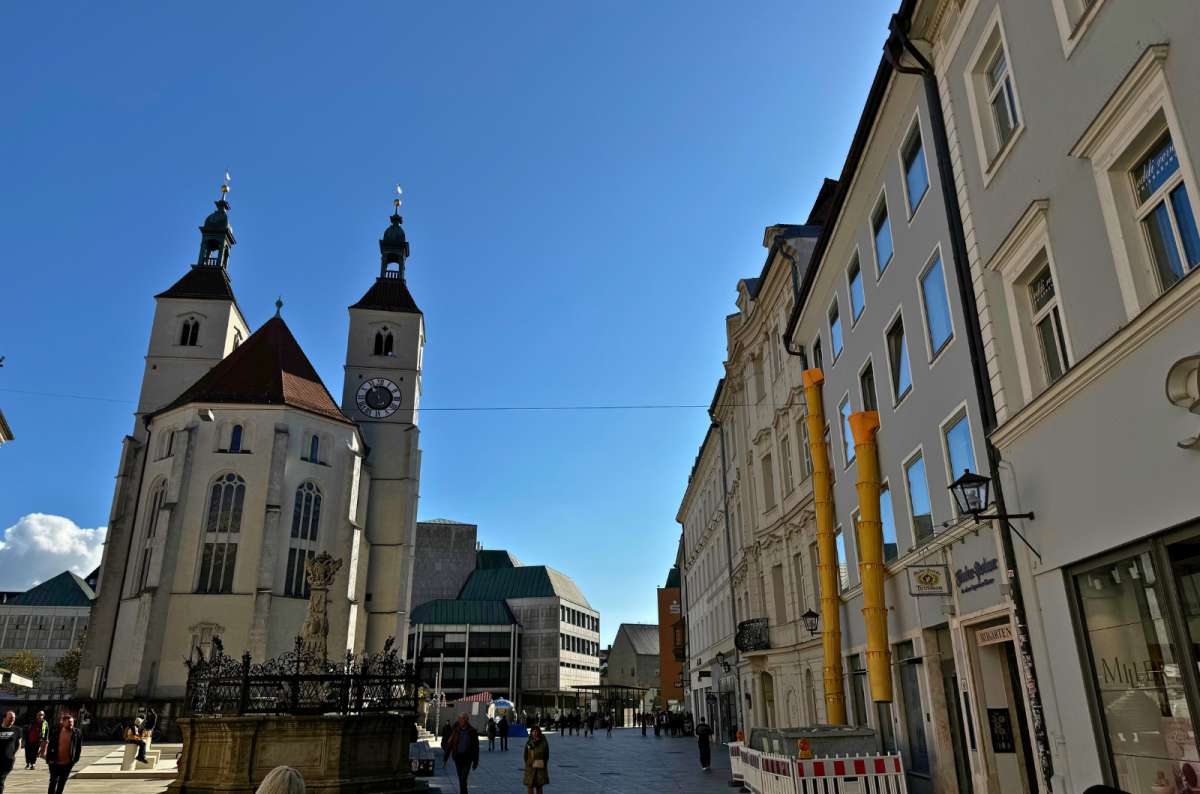
Neupfarrplatz is one of the two squares in Regensburg where life happens
- Why it’s worth it: The heart of Regensburg’s Old Town—good for people-watching and grabbing a break (or a beer).
When you’re visiting Regensburg’s Old Town, Neupfarrplatz and Haidplatz are the two central squares that you’ll be wandering around the most.
Neupfarrplatz is the bigger one, built on top of what was once Regensburg’s Jewish quarter. It’s home to the not-too-exciting New Parish Church (Neupfarrkirche). When I visited, the whole thing was half-covered in scaffolding. This square is where the standard “square” things happen—markets, street musicians, benches.
Haidplatz is the more atmospheric one. It’s surrounded by historic buildings and cafés, it’s busier and feels older. This is where the old patrician city meets modern local life. Again, not much to actually do here but take a stroll or a sit.
Neither of these are “must-see Regensburg attractions” on their own. But when you're figuring out what to do next when you’re in Regensburg for a day, they’re great spots to reset and gather your bearings.
8. Old Town Hall, Where a 143-Year-Long Meeting Was Held
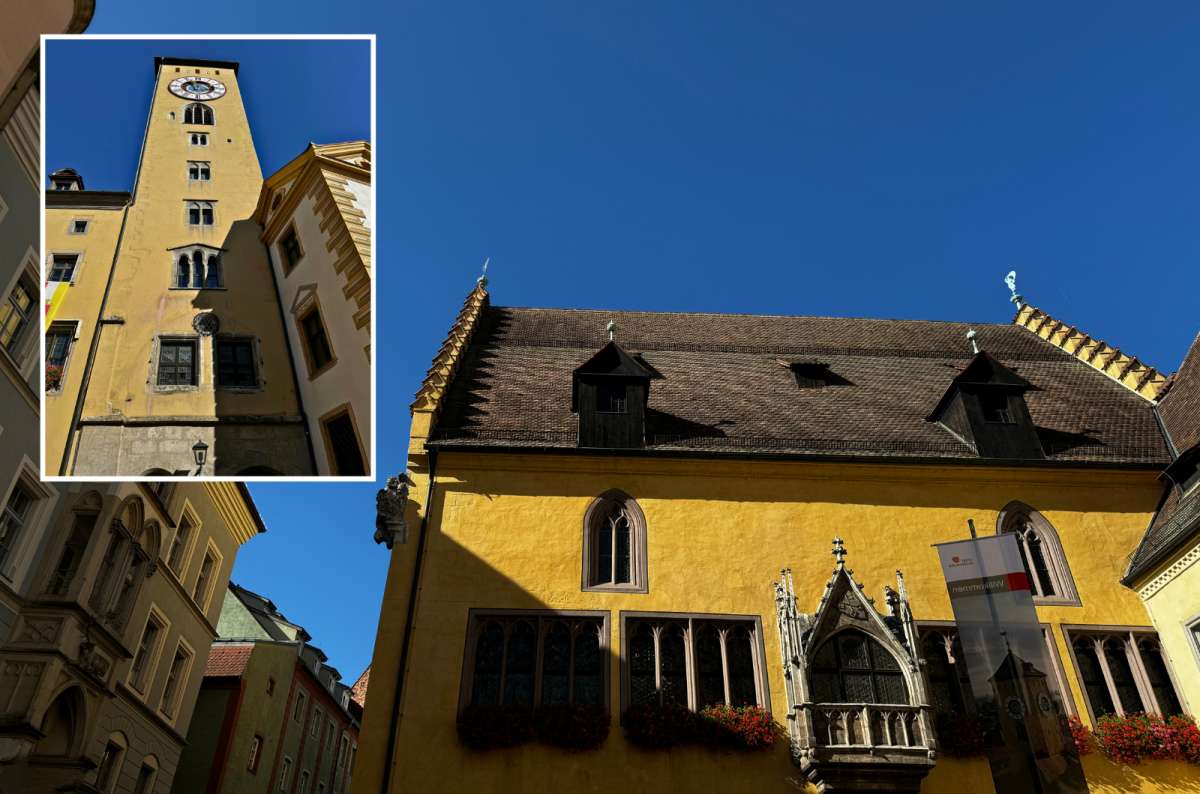
The Altes Rathaus stands out with its sunny yellow walls and spiky Gothic details
-
Why it’s worth it: A 55-meter Gothic tower that still dominates the square, plus a rare peek into how medieval politics worked.
-
English tours are on daily at 2 pm
The Altes Rathaus (Old Town Hall) is Regensburg’s original town hall—it’s easy to spot because of the large clock on top of the tower.
The oldest part of the building dates back to the 13th century. You can visit on a guided tour and see that the inside is, in fact, still very old-looking. Very… wooden.
Town Hall tour information
You can join a daily English tour for about 60 minutes, or go on the German one and get an English audio guide that’ll help you make sense of it all. You’ll see the Imperial Hall, the courtroom, the meeting room, and even the torture chamber and dungeon.
But even if you skip the tour like I did, the building is absolutely worth seeing from the outside, considering its historical significance.
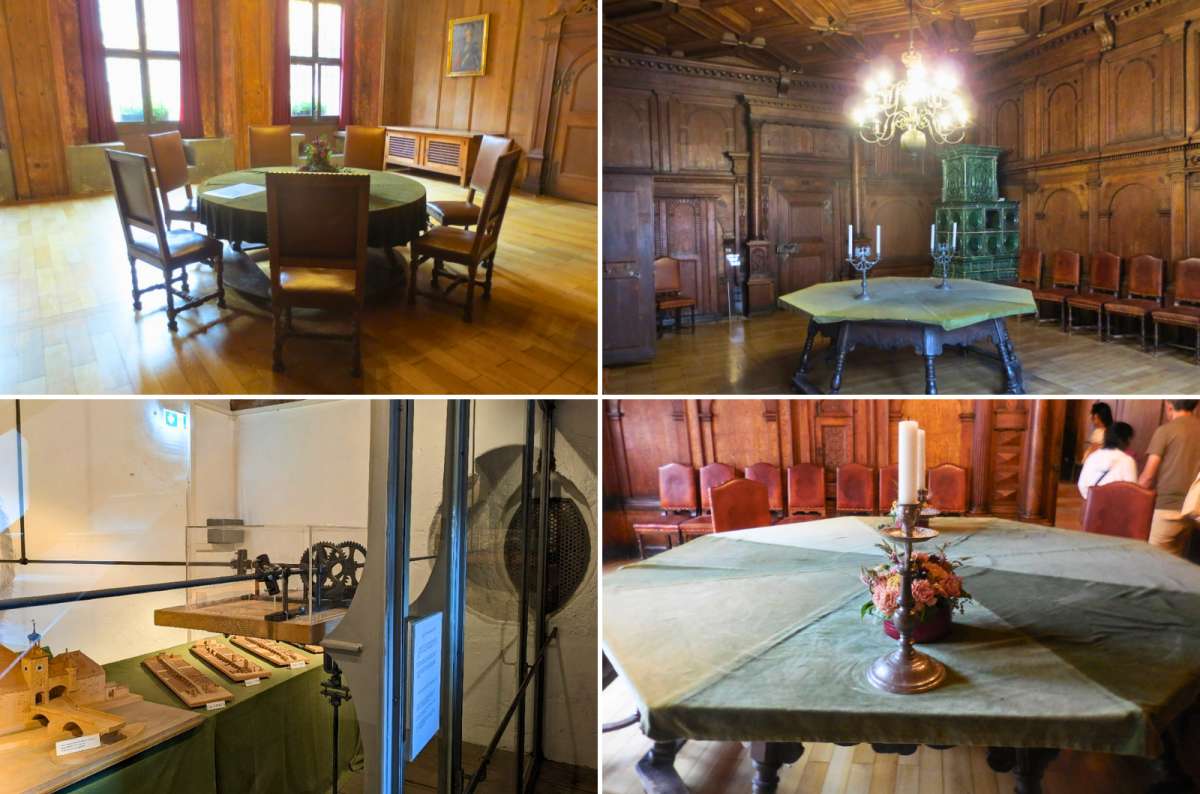
Tour or no tour, the Altes Rathaus is worth a stop—inside you'll find dungeons and imperial drama, outside you’re looking at centuries of history
Fun fact: From 1663 to 1806, the Rathaus hosted the Perpetual Imperial Diet, which basically means the Holy Roman Empire’s most powerful people argued here for 143 years straight. It started as a regular imperial assembly, where representatives from all over the empire came together to negotiate, make laws, and try not to go to war.
Then they just... never officially ended the meeting, never traveled to imperial capitals for further meetings, and just kept on going, on and off, for 143 years in Regensburg.

9. The Old Chapel—Bavaria’s Oldest Catholic Church
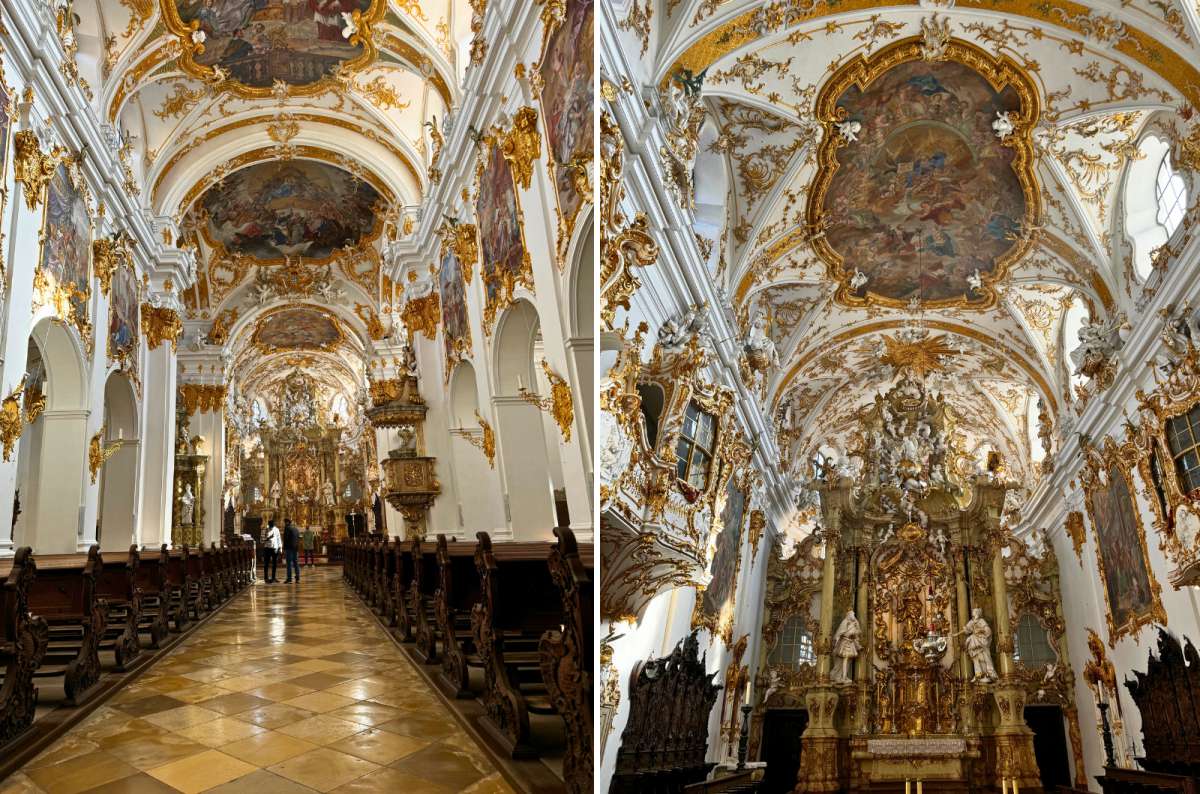
Welcome to the Old Chapel—where Rococo went full throttle. Gold on gold, angels everywhere, and ceiling art that looks like it could float right off
-
Why it’s worth it: It’s the oldest Catholic church in Bavaria.
-
Free entry
Regensburg has too many churches. You don’t need to see all of them. But The Old Chapel (Basilica of the Nativity of Our Lady) is worth a stop. I went in because it’s the oldest Catholic church in Bavaria.
You don’t need a lot of time here, but you’ll notice right away how insanely ornate it is compared to the other churches you see in Regensburg. The inside is full on Rococo: everything is gold, swirled, frosted, or painted.
If you only visit one church that isn’t the cathedral, make it this one.
10. House of Bavarian History—A Must-See Museum in Regensburg for Real Context

Sleek outside, stuffed with Bavarian quirks inside
- Why it’s worth it: It’s cool on the outside and packed with Bavarian trivia inside.
- Price: EUR 10
- Opening hours: Daily except Mondays 9 am–6 pm
It wouldn’t be me if I didn’t go to at least one full-blown museum anywhere I travel to. And the House of Bavarian History (Haus der Bayerischen Geschichte) was my chosen museum in Regensburg.
If you’re doing a full tour of Bavaria (and you should—here’s my 7-day Bavaria itinerary), this place is educational gold.
It covers Bavarian history from 1800 to today. You’ll see everything from royal crowns and vintage cars to traditional fashion and beer bottles.
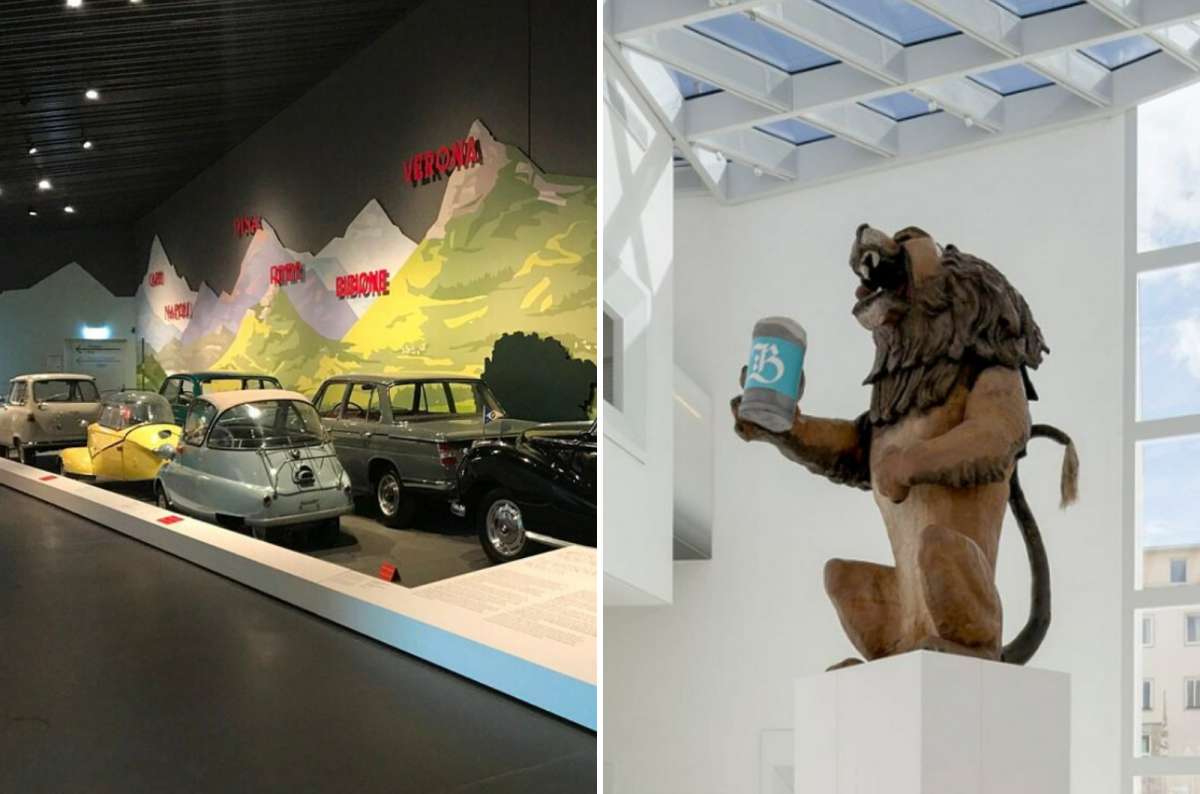
A giant Oktoberfest beer lion welcomes you inside
There’s an audio guide that takes you around the highlights in about 60 minutes, but props to them for having good English signage too.
Not essential if you're in Regensburg just for the vibe—but if you want context (I always do!), this is where you get it.
Sample Itinerary: One Day in Regensburg
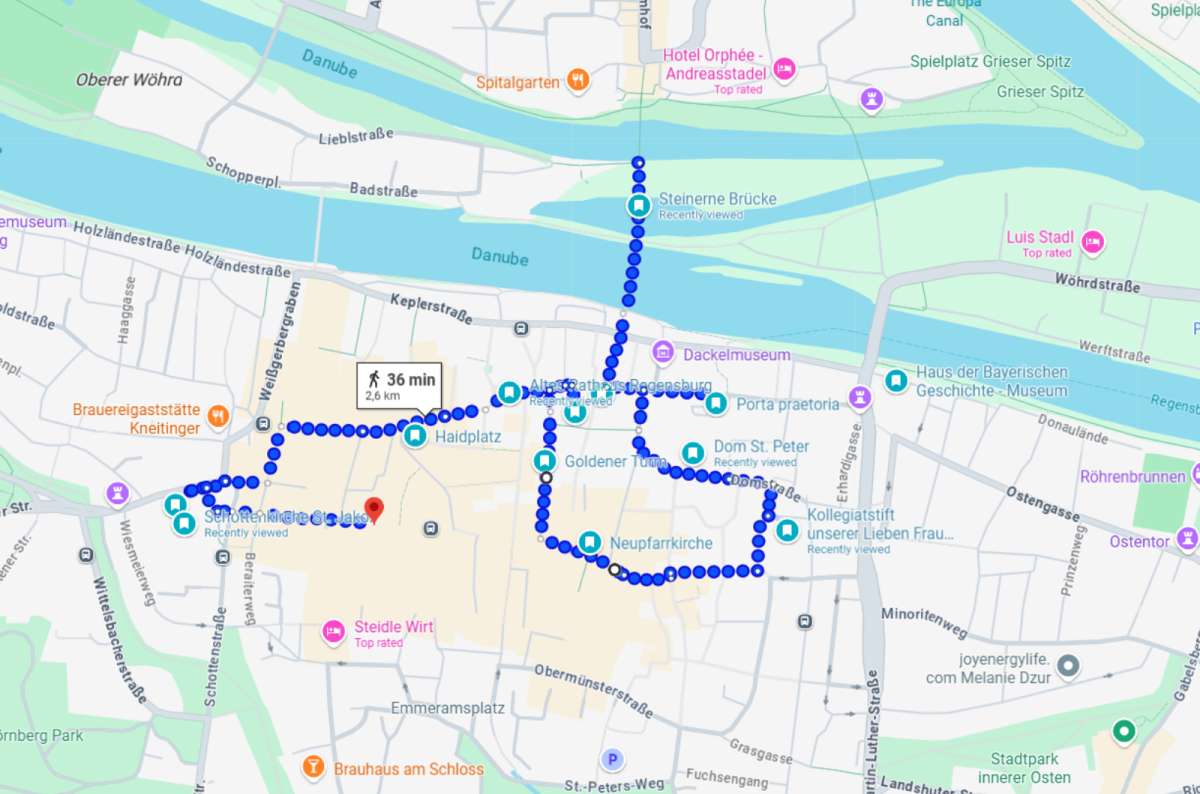
You can see the Old Town is compact and you’ll hit the highlights of Regensburg easily on a day trip (+ the short drive to the Walhalla)
Morning
-
Walk across the Stone Bridge (15 minutes)
-
Spot Goliathhaus (5 minutes)
-
Check out Porta Praetoria (10 minutes)
-
Step into St. Peter’s Cathedral (20 minutes)
-
Walk through Neupfarrplatz (10 minutes)
-
Look up at the Golden Tower and Baumberger Tower (10–15 minutes)
-
Visit the Old Town Hall (5 minutes of staring or 1 hour for the tour)
-
Lunch and coffee break at Haidplatz or Kaffeehaus (1 hour)
Afternoon
-
Visit St. Jakob Church & Scots Monastery (20–30 minutes)
-
(Bonus) Climb Trinity Church’s tower (20 minutes)
-
Stop at the House of Bavarian History (1 hour)
-
Drive to Walhalla (15-minute drive, 45-minute visit)
Final Tips for Visiting Regensburg
-
Coffee tip: Just a few steps from the Old Town Hall, we found a small café called Kaffeehaus. It’s exactly what we needed after half a day of churches and towers. It’s small and friendly and the coffee and snacks were more than decent. I was happy and my girlfriend, based on how quick she demolished her salad, was too.
-
Plan for a half-day: You don’t need a full day in Regensburg unless you’re taking it very slow and including every single spot on this list or adding the Thurn und Taxis Palace (which I decided to skip).
-
Parking: If you’re visiting Regensburg by car, try coming on a weekend. Street parking is often free on Saturdays and Sundays. Most of the top things to see are close together in the Old Town, so you’ll want to walk anyway.
-
Climb a tower: If you really want to climb at least one tower in Regensburg, try Trinity Church. You get a pretty view of the surrounding rooftops and a uniquely decorated church interior—it’s like ceiling lacework.
FAQs
Is Regensburg a day trip from Munich?
Yes. It takes about 1.5 hours by train or car, making Regensburg an easy day trip from Munich. Trains leave regularly from Munich Hauptbahnhof (main station) and drop you off just a short walk from the Old Town in Regensburg—no extra transport needed. You’ll want to start pretty early in the morning if you want to be back in Munich by dinner.
Can I visit Regensburg from Nuremberg?
Definitely. I did exactly that, you don’t really need a full day in Regensburg, so you’ll have enough time. It’s just over an hour by car and around the same by train.

Nuremberg by afternoon
What other places can I visit near Regensburg?
Nuremberg is the obvious heavyweight nearby. If you’ve got more time, Bamberg is also a great choice—both are UNESCO sites and offer a very different flavor of “old city” compared to Regensburg.
Sometimes, all you need to do is take the first step... I've filtered out the best hotels in Regensburg for you.
Save it for yourself to come back to later, or share with your friends on social media!
You might also be interested in reading:
This post contains affiliate links. If you make a booking through one of my links, I may earn a small commission—at no additional cost to you. Thank you for your support!
Quick Look: The Best Things to Do in Regensburg
Map of Regensburg sightseeing highlights
So why do I recommend just half a day in Regensburg?
1. Regensburg’s Stone Bridge and the Best View of the Cathedral
2. Regensburg’s St. Peter's Cathedral: An Iconic Building with Incredible Organ Music
3. Walhalla Memorial—A Must-See Near Regensburg
4. Porta Praetoria—A Roman Gate Hiding in Plain Sight
5. Goliathhaus and Regensburg’s Patrician Towers—How Rich Merchants Tried to Outbuild Each Other
6. St. Jakob Church aka Scots Monastery–See Regensburg’s Romanesque Hidden Gem
7. Neupfarrplatz and Haidplatz—Explore Regensburg’s Old Town Squares
8. Old Town Hall, Where a 143-Year-Long Meeting Was Held
9. The Old Chapel—Bavaria’s Oldest Catholic Church
10. House of Bavarian History—A Must-See Museum in Regensburg for Real Context
Sample Itinerary: One Day in Regensburg
Final Tips for Visiting Regensburg
Is Regensburg a day trip from Munich?
Can I visit Regensburg from Nuremberg?




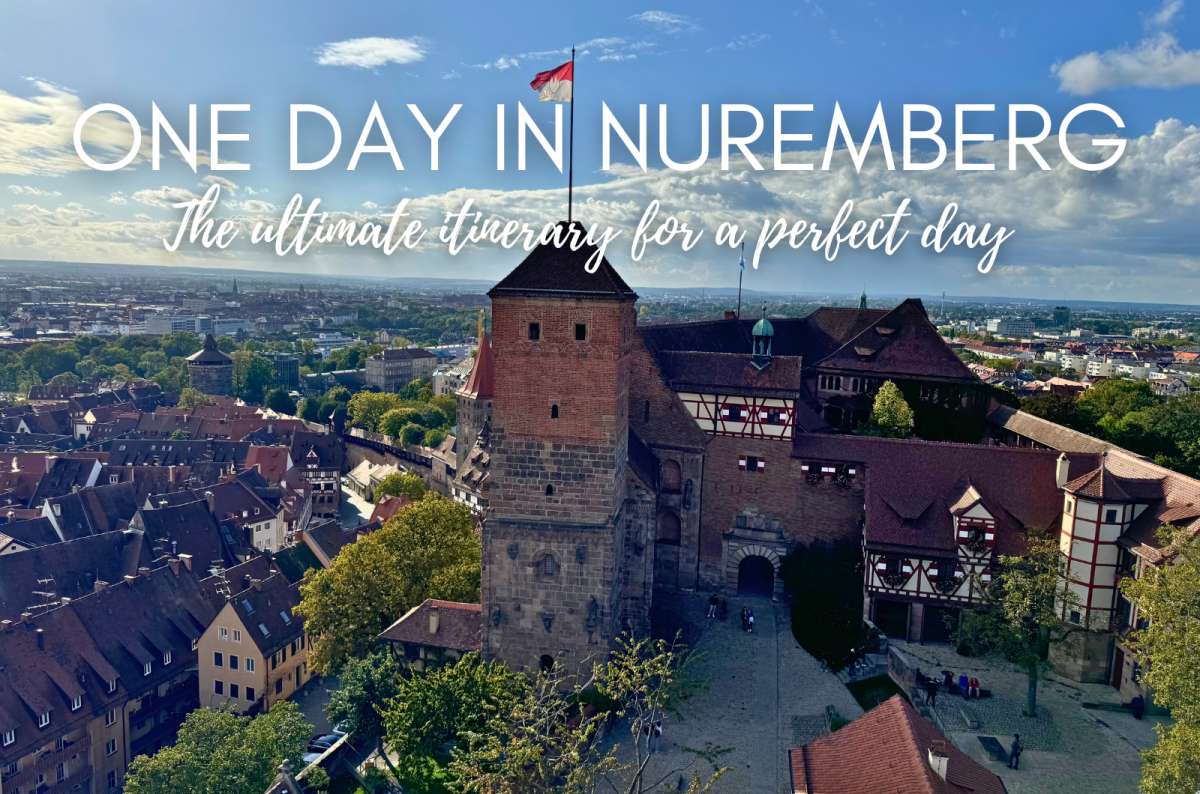

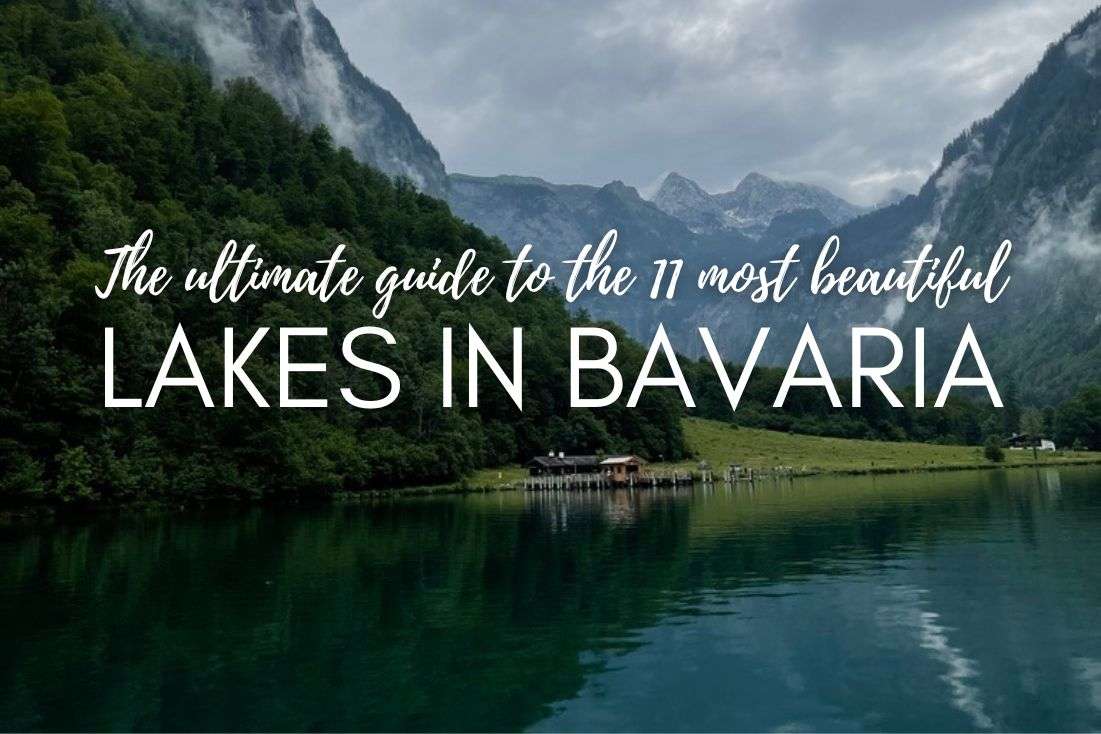



Comments | Thoughts? Give us a shout!